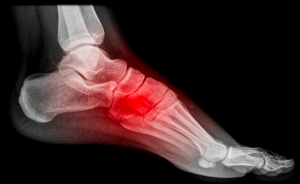What causes a stress fracture?
 When high-impact forces are repetitively put on a bone, tiny cracks may form. Over time and with more stress to the bone, these cracks can continue to grow and begin to cause painful symptoms. This is a stress fracture. Any activity or condition that results in pressure and heavy loads on a bone can lead to the development of a stress fracture. This includes:
When high-impact forces are repetitively put on a bone, tiny cracks may form. Over time and with more stress to the bone, these cracks can continue to grow and begin to cause painful symptoms. This is a stress fracture. Any activity or condition that results in pressure and heavy loads on a bone can lead to the development of a stress fracture. This includes:
- High-impact physical activities such as running
- A sudden increase in training intensity
- Poor foot biomechanics or alignment issues
- Unsupportive footwear
- Increased weight
- Malnutrition
- Decreased bone density
What are the symptoms?
Because the damage from stress fractures build up over time, the pain can come on gradually without being linked to a certain incident or event. Symptoms at the fracture site can include:- Pain, ranging from mild to severe
- Localised tenderness
- Pain is exacerbated by weight bearing or physical activity
- Pain settles with rest
How are stress fractures treated?
The first part of treatment focuses on relieving the painful symptoms. This can be achieved using the PRICE principles (protection, rest, ice, compression, elevation). The focus of treatment is then to facilitate the healing and repair of the fracture and address the cause to reduce the risk of it happening again. This may include:- Orthotics to address any biomechanical and alignment issues of the feet and legs that may be resulting in increased stress through bones
- Footwear assessment to ensure the shoes are helping and not hindering recovery, and are not causing increased loading through certain bones
- Activity modification to avoid activities that will overload the same bone and cause more damage
- Stretching and strengthening of muscles that may have contributed to the biomechanics of the feet that caused the stress fracture
- Moonboots or braces may be used








